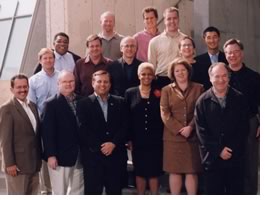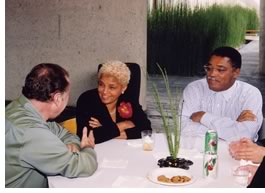
by Aaron Koch
Program Coordinator, Mayors Institute of City Design
The Mayors Institute on City Design convened mayors and design professionals from across the country October 23–25 in La Jolla, Calif., to discuss the importance of design in communities. This unique program, which has brought together more than 500 mayors with a diverse group of design and development professionals since its inception in 1986, is carried out in partnership with the U.S. Conference of Mayors and the American Architectural Foundation.
 The
La Jolla event opened with a dinner at the prestigious Salk Institute
and a keynote address by former Cincinnati Mayor Roxanne Qualls, who spoke
about how her experience at the Mayors' Institute in 1996 supported her
efforts to redevelop Cincinnati's waterfront. At that time, she said,
Cincinnati's busy highway disconnected the city's downtown from its waterfront,
which was characterized by a patchwork of parking lots and obsolete stadiums.
During her four-year tenure, Mayor Qualls oversaw more than $1.3 billion
in public investment that transformed the waterfront with two new sports
stadiums, underground parking, the National Underground Railroad Freedom
Center, and a freeway redesign that has reconnected the street grid and
made the area accessible to pedestrians.
The
La Jolla event opened with a dinner at the prestigious Salk Institute
and a keynote address by former Cincinnati Mayor Roxanne Qualls, who spoke
about how her experience at the Mayors' Institute in 1996 supported her
efforts to redevelop Cincinnati's waterfront. At that time, she said,
Cincinnati's busy highway disconnected the city's downtown from its waterfront,
which was characterized by a patchwork of parking lots and obsolete stadiums.
During her four-year tenure, Mayor Qualls oversaw more than $1.3 billion
in public investment that transformed the waterfront with two new sports
stadiums, underground parking, the National Underground Railroad Freedom
Center, and a freeway redesign that has reconnected the street grid and
made the area accessible to pedestrians.
Universal issues
Each mayor presented a specific case study of an issue facing his or her
city, then spent two days discussing effective approaches with a team
of design experts in architecture, landscape architecture, urban planning,
structural engineering, financing, and development. Though each city's
issue was unique, they all proved indicative of larger trends in American
cities.
• Atlanta's Mayor Shirley Franklin faces reconnecting a city divided
by freeways and the complexities of creating successful pedestrian
connections and elegant civic infrastructure.
• Hartford's Mayor Eddie Perez is hoping to build a downtown
residential base to enliven the city's core.
• Revitalizing riverfronts
by creating successful mixed-use communities is the goal of both Mayor
Paul Pate of Cedar Rapids, Iowa, and Mayor David Ransburg of Peoria, Ill.
• Spokane's Mayor John Powers is working with the citizens of his
community to develop a long-term vision to protect
the natural landscape around the Spokane River Falls as a sustainable
urban amenity.
• In Syracuse, Mayor Matthew Driscoll is faced with the opportunities
and challenges created by the construction of DestiNY, a $2.2 billion
entertainment and retail destination.
• Mayor James Gibson of the rapidly growing city of Henderson, Nev.,
is working to create a lively downtown
public plaza while planning for future community transformations.
 Help
from designers
Help
from designers
The mayors worked with a talented and experienced team of design professionals
to generate ideas, better understand the potential of design, and determine
strategies that will guide future decisions concerning the built environment.
Participating designers included:
• Dennis Carmichael, landscape architect, EDAW, Alexandria, Va.
• John Eddy, structural engineer, Arup, San Francisco
• Cindy Holler, development consultant, Fannie Mae, Chicago
• John Kaliski, AIA, architect and urban designer, Urban Studio,
Los Angeles
• Peter Park, director of planning, City of Milwaukee
• Stanley Saitowitz, architect, Natoma Architects, San Francisco
• Bryan Shiles, AIA, architect, Gordon H. Chong & Partners, San
Francisco
• Michael Willis, FAIA, architect, Michael Willis Architects, San
Francisco.
Billie Tsien, AIA, Tod Williams Billie Tsien & Associates, New York City, led a tour of the meeting venue—her firm's award-winning Neurosciences Institute facility—and gave a presentation about the building's design process. Tsien also described her work as the only architect on the Lower Manhattan Development Corporation board and discussed her firm's recently completed American Folk Art Museum, the first new museum to be built in New York City in more than 30 years and recipient of the Arup World Architecture Award for Best Building in the World, 2002.
The goal of the Mayors' Institute is for participants to return to their cities with greater insights on how, as mayors, they can implement solutions that will improve the quality of life in their cities. The program holds six three-day sessions a year in locations around the country. For more information on the Mayors' Institute on City Design, visit their Web site or email their information center.
Copyright 2002 The American Institute of Architects. All rights reserved.
![]()
|
The program holds six three-day sessions a year in locations around the country. For more information on the Mayors' Institute on City Design, visit their Web site or email their information center. |
|